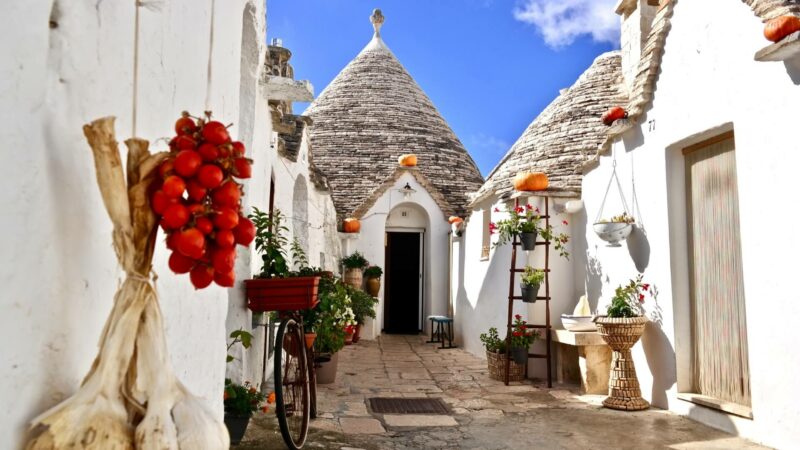Campania enjoyed from the sea
With Pavarotti’s voice in the background: the “old terrace overlooking the Gulf of Sorrento” (a heart-wrenching piece by Lucio Dalla) is the ideal place to admire the sea of Campania and its entirety. Our choice is to stop here, surrendering to the enchanting songs of the Sirens (who, according to Homer, tempted Ulysses right here) and indulge in tasting the delicacies of the area: olive oil, tomatoes, lemons (outstanding lemoncello and lemon delight), the monk’s provolone (the king of the table), sorrentina-style gnocchi, and squid. Alternatively, you can embark towards the Neapolitan coast where the islands of Capri, Ischia, and Procida await you. Capri, besides the iconic Faraglioni and the iridescent waters of the Blue Grotto, offers a visit to Villa San Michele and the majestic Mount Solaro. For a more crowded experience, a stop at the famous square is a must, to feel like in a movie (and imitate Jackie Kennedy, who loved to stroll here) amid shops of major brands, restaurants, and artisan workshops.
Behind Sorrento, instead, the entire Amalfi Coast unfolds, stretching from Positano to Vietri sul Mare, for 40 km of wanderlust perched on the sea, including 15 municipalities. Amalfi is the wondrous one: a true balcony suspended between the blue of the water and the green slopes of the Lattari mountains, with terraces cultivated with citrus fruits, vines, and olive trees. A former Maritime Republic, with a very oriental-style urban layout between alleys and stairways, in Amalfi, the emotion is yellow-colored, with the intense scent of IGP lemons, called “sfusati” for their elongated and tapered shape, and the floral bouquet of Ginestra (known as Biancatenera) which is the heroic grape variety of white DOC Costa d’Amalfi. In the picturesque Ravello, you will be enchanted by the gardens and architectures of Villa Cimbrone, where the Terrace of Infinity will fill your gaze with grace. In Vietri sul Mare: the dome of San Giovanni Battista, the alleys, the shops, the restaurants, the railings… everything resonates with the cheerful colors of its traditional ceramic craftsmanship. To conclude, take a boat ride after a dip in the bays of Praiano and the striking Fjord of Furore, admiring the wild beauty of these wonders on the water.
Naples, where nobility belongs to the people
The music of Naples? Well, it is the incessant chatter of people, with the fluctuating rhythm of contrasts. Naples is the emblem of all Southern cities: beautiful and impossible, chaotic and engaging, enchanting with its blend of popular culture and artistic creativity, architectural grace and unbridled genius, unseen beauty and hidden masterpieces underground. Ancient and modern is merged in a disorienting dance of colors, scents, and rhythm. You will notice this simply by strolling towards the grand Piazza Plebiscito, opening in front of the Royal Palace (for centuries the nucleus of power of Southern Italy) and closing with the colonnade of the Basilica of San Francesco di Paola. Just a stone’s throw away stands Castel Nuovo, although everyone calls it Maschio Angioino, a center of culture that hosted artists and writers such as Giotto, Petrarch, and Boccaccio. A bit further stands Castel dell’Ovo, an ancient fortress but also a monastery, prison, and royal residence.
If you want a coffee break, ask for a tazzulella e cafe in one of the historic cafes, where art is not only gastronomic but also literary, architectural, pictorial. Among the streets and squares that represent the most authentically popular symphony of Naples: via San Biagio dei librai, better known as Spaccanapoli because it cuts through the town. It reveals along its path gems of rare beauty – such as the Monastery of Santa Chiara and Piazza del Gesù – alongside a crescendo of eateries offering the best of street food: folded pizza to take away and eat on the go, fried pizza (since 2017, the art of the pizza maker is intangible cultural heritage of UNESCO), cuoppo of fried foods, and pagnottiello stuffed with cold cuts and cheese. Along Via dei Tribunali, you will find artisan shops, seafood stalls, and fruit stalls, in a jubilation of neomelodic songs and laundry blowing in the breeze. At a certain point, you will intersect with Via San Gregorio Armeno, the famous street of nativity scenes. Here, you will also find one of the entrances to the Napoli underground, for a journey into the belly of the city, through a labyrinth of galleries and tunnels that tell tales of secrets, intrigues, and the Resistance. At Piazza San Domenico, one of the most characteristic squares of Naples, sampling a sfogliatella (riccia or frolla) is a must. Adjacent to it, you will discover the gem of the San Severo Chapel, where music becomes mysterious, and your hearts will be pierced by the beauty of the Veiled Christ, one of the most poignant sculptures in the world. The mural dedicated to Maradona, another genius who painted symphonies with the soccer ball, can be found in the Spanish Quarters, among the most folkloric areas of the city. One of the alleys is entirely dedicated to Totò, featuring a long line of street artwork portraying the Prince of Laughter in his traditional masks.









